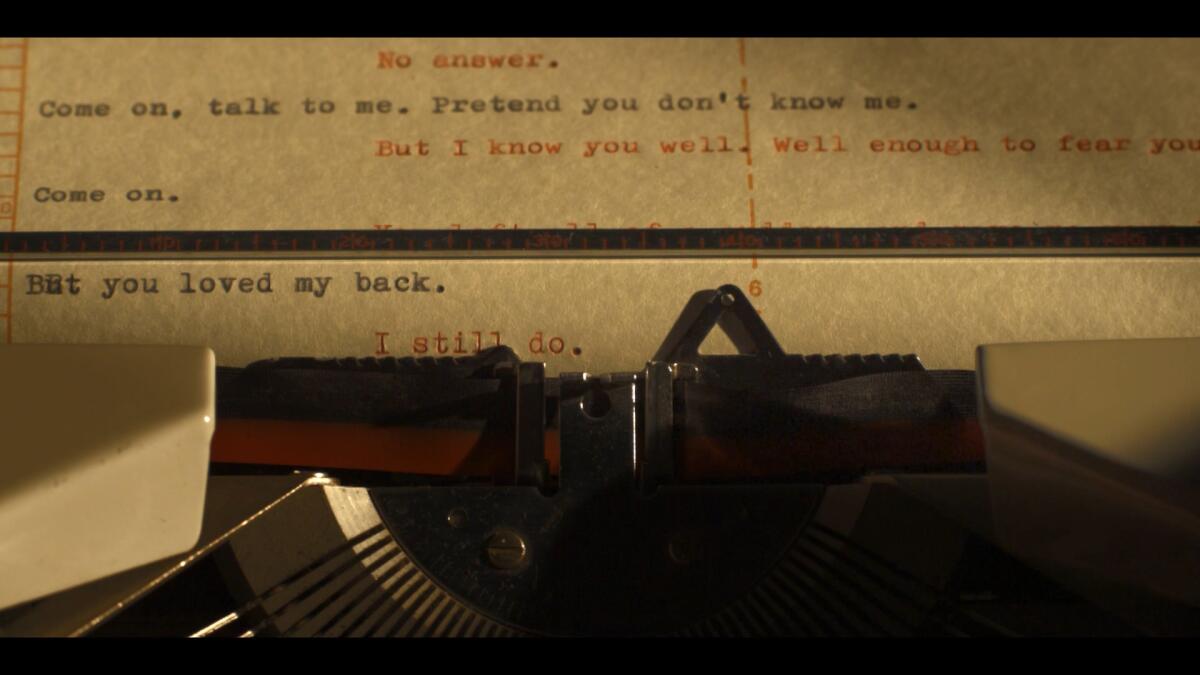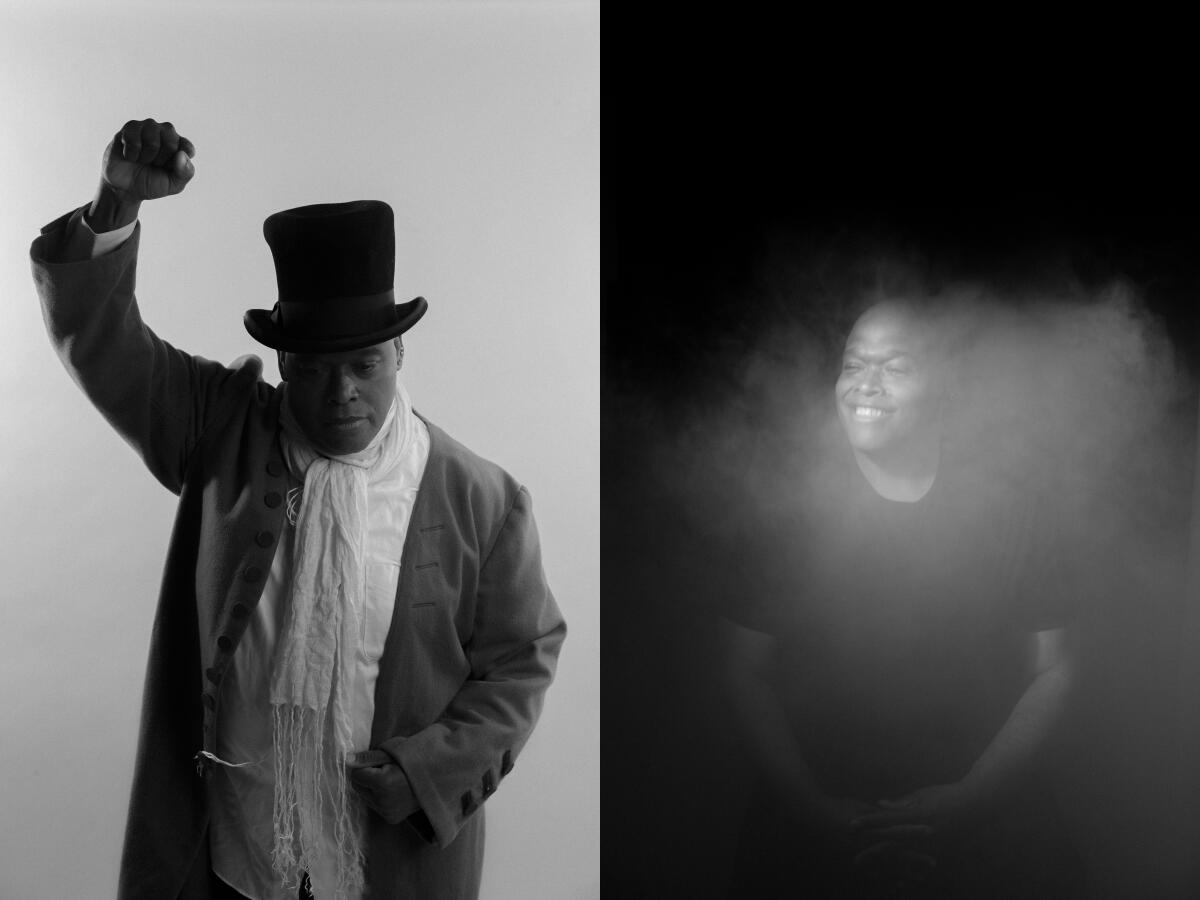For a week filled with hate, an Atlanta show offers a counter: Love

- Share via
How to open any missive in a week of agonizing tragedy? Perhaps by taking a breath, listening to a 14th century mass and reflecting on what gives our lives real meaning. I’m Carolina A. Miranda, arts and urbanism columnist at the Los Angeles Times, with the week’s essential arts news:
Love is a many-splendored thing

The film begins with four words on a piece of ruled paper embedded in the carriage of a typewriter. “Hello sexy,” it reads. “hello u.”
Over the 11 minutes that follow, a conversation proceeds to unfold on the page, one that draws on the conventions of text messaging and emailing, with their abbreviated, rapid-fire exchanges, but presents them as they are ploddingly tapped out, letter by letter, on an old typewriter.
The conversation is a fraught one — between two men, old lovers. One has materialized out of nowhere after disappearing a decade prior. Now they gingerly reestablish a connection, one filled with deep yearning, unspoken recriminations and the echoes of a dormant familiarity that has now come roaring back to life.
“Tomorrow Everything Will Be Alright,” 2010, by Akram Zaatari, conveys the thrill of love, the pain of love, materializing on a page one achingly typewritten letter at a time. And I haven’t been able to stop thinking about it since I saw it at the High Museum in Atlanta early this week in a group exhibition, “What Is Left Unspoken, Love,” that examines love in its many facets.
In fact, I haven’t just thought about Zaatari’s film, I’ve rewatched it multiple times. (His gallery, Kurimanzutto, has helpfully posted it to Vimeo.)
Make the most of L.A.
Get our guide to events and happenings in the SoCal arts scene. In your inbox every Monday and Friday morning.
You may occasionally receive promotional content from the Los Angeles Times.
In a week and month sullied by the senseless violence of mass shootings, “What Is Left Unspoken, Love,” couldn’t be more timely — more needed.
Organized by Michael Rooks, the museum’s curator of modern and contemporary art, the exhibition takes as its subject not trite romance but the many loves that permeate our lives: our romantic unions, but also our connections to family, to community, to art and to greater cosmic forces — loves that demand generosity, abnegation, spiritual surrender.
The exhibition by no means attempts a comprehensive cataloging of art about love. That would be exhausting — and impossible.
Instead, it reads more like meditations on the different ways love can manifest in our lives. Works dating from 1990 to the present are organized thematically. The show opens on the concept of “The Two,” the union of couples in their myriad forms, and from there proceeds to other definitions of love: “The School of Love,” which considers the ways we learn to love; “The Practice of Love,” in which it is expressed through acts of intention or self-discipline; “Loving Community,” inspired by the Rev. Martin Luther King Jr.’s visions of brotherly love and social justice; “The Poetics of Love,” on how it’s put into words; and “The Love Supreme,” which considers love in the context of union with God or with nature.
The show includes direct invocations of love, such as Zaatari’s poignant short film. But it also includes more abstract and philosophical interpretations, including Andrea Galvani’s video installation “The End (Action #5),” 2105, which shows a sun that never quite sets over the ocean. The looped video, shot from a military aircraft flying at supersonic speeds against the Earth’s rotation, shows the sun over a watery horizon. Because of the plane’s speed, the sun never slips below that horizon. The speed and power of the aircraft feel thunderous, even as the sun remains frozen in its un-set state.
The sensation is that of something inconclusive, unconsummated, unrequited.

Throughout the exhibition, works ricochet off one another in this way — concrete depictions of love amid others that leave you mulling the exact meaning.
Felix Gonzalez Torres’ “Untitled (Perfect Lovers),” 1987-1990, features a pair of synced wall clocks that un-sync over time, as humans are wont to do, while Rashid Johnson’s video “The Hikers,” 2019, captures a pair of figures who joyously revel in the mutual recognition — bonded by Blackness. Carrie Mae Weems’ celebrated “The Kitchen Table Series,” from 1990, tugs at many threads in the show. In it, the artist renders herself in fictionalized form over a sequence of photographs that capture her with a lover, with friends, with her children, by herself — love and its absence are present in so many ways.
Painter Kerry James Marshall’s “Souvenir I,” 1997, shows a winged figure inhabiting a tidy living room framed by civil rights leaders and other activists who died in the 1960s — a way of recording love and its loss. In that same vein are the graphic pieces produced by the collective General Idea in the 1990s, at the height of the AIDS epidemic, that reproduced the word “AIDS” in the style of Robert Indiana’s “LOVE” graphic.
AA Bronson, one of the founders of General Idea, is quoted in the catalog describing the ways in which the indiscriminate death visited upon gay men during the AIDS pandemic shaped notions of love: “On a personal level, I was forced to acknowledge my love, a love that would have been shameful a few years before.”

The exhibition concludes with “Pulse Room,” an electric (literally) installation by Rafael Lozano-Hemmer: The ceiling is lined with incandescent lightbulbs. Grab a set of handheld sensors in one corner of the room and, for a few seconds, the lightbulbs will beat in sync with your heart, after which they seem to devolve into a more chaotic pattern. That pattern is set by each successive visitor, who adds their heartbeat to the beats that came before — each registered by individual lights.
Hearts beating in a room. Like a couple holding hands in a movie theater. Like a room full of worshippers at a Mass. Like the kids in that classroom in Texas.
Love is joy. It is also terrible grief.
“What Is Left Unspoken, Love,” is on view at the High Museum in Atlanta through Aug. 14.
Visual arts
The pandemic has marked a challenging time for Takashi Murakami. There were the personal losses: the death of his father, and his friend designer Virgil Abloh. And there were the professional ones: Shows were postponed, and his company, Kaikai Kiki, almost went bankrupt. Like so many others, the artist spent the pandemic hunkered behind a screen — which has led him down new paths artistically. The Times’ Deborah Vankin hung with Murakami on the eve of the opening of his new one-man show at the Broad museum. “It’s no surprise,” she writes, “that he’s now emerging in this late stage of the pandemic with new work, both a physical painting and a foray into augmented reality and other digital realms.”

Times art critic Christopher Knight reviews “Persia: Ancient Iran and the Classical World” at the Getty Villa. It’s a thousand years of history covering three Persian empires — a lot to fit into the museum’s three small rooms. Think of it, writes Knight, as “a thumbnail sketch of a thumbnail sketch.” Even so, “there are wonderful individual objects to see,” he writes. The exhibition, the first major museum show of its kind, also serves to integrate the narratives of Persian history into an institution known primarily for its Greek and Roman artifacts.
On and off the stage
Numerous musicals — such as “Dear Evan Hansen” and “Public Domain” — have taken on the internet as subject and character. But a new musical by Dave Malloy titled “Octet,” which is on view at the Berkeley Repertory Theatre through the weekend, “manages to capture a life lived Too Online in a way that no stage show has before now,” reports The Times’ Ashley Lee. “Without romanticizing its prospects, satirizing its users or villainizing its makers, the show is an honest, nuanced exploration of how much of our daily lives are now lived on the internet — and how our institutions, our social norms and our very brains are paying for it.”

The Times’ Kristina Garcia reports that Melinda Lopez’s play “Mala” is returning to San Diego’s Old Globe next month — and this time will include performances in Spanish as well as a presentation in Tijuana. The play, about caring for the dying, was inspired by Lopez’s own experiences caring for her dying mother. “The play — although it’s beautifully structured and it’s an elegant story — it’s a story of chaos,” says director David Dower. “It’s a story of careening from one mistake to another mistake, basically, told with a great deal of humor.”
Antaeus Theatre Company’s production of “Hamlet” opened last week at the Kiki & David Gindler Performing Arts Center in Glendale. Times theater critic Charles McNulty reports that director Elizabeth Swain’s interpretation of Shakespeare’s classic is modest. “The focus is on beats, acting moments, rather than more sweeping arcs,” he writes. “Scenes, scrupulously played, succeed each other without a fresh understanding of the tragedy coming into view.”
Enjoying this newsletter? Consider subscribing to the Los Angeles Times
Your support helps us deliver the news that matters most. Become a subscriber.
McNulty also talks to Randy Rainbow about his new memoir, “Playing With Myself.” Rainbow, who rose to social media fame with raucous musical-theater-inspired spoofs of the Trump presidency, turns a frank lens on his upbringing at the hands of a Trump-like father. “It was an interesting insight for people who have been following me all these years to find out that the guy who became known as Trump’s nemesis at least on social media is the spawn of a clone of Donald Trump,” he tells McNulty.
For the record:
1:22 p.m. May 31, 2022An earlier version of this article referred to Louise Braille as the inventor of an alphabet for the blind. It was Louis Braille.
Plus, Times photographer Robert Gauthier has a stirring photographic portfolio of the performers appearing in a new production of the musical “The Braille Legacy,” which will take the stage at Inglewood’s Miracle Theater on June 24. The show was inspired by the story of Louis Braille, the inventor of an alphabet for the blind. The new staging represents the first time that the musical, which first premiered in London in 2017, will be presented with a visually impaired cast.

Classical notes
On June 12, when “Aida” comes to a close on the L.A. Opera stage, so will another chapter in the company’s history: Tenor George Sterne will step down from his post after more than 150 performances, more than any chorus member in the company’s history. “Sterne has been with the L.A. Opera since before there was an L.A. Opera,” writes contributor Jordan Riefe. “He’s seen it all: the revolving door of big-name guest directors — Julie Taymor, William Friedkin, Franco Zeffirelli. The divas and dilettantes. He’s taken the spotlight and taken pratfalls. Now, he’s taking his final bow.”

Essential happenings
Matt Cooper has six essential culture picks for the weekend, including a performance of “Sleeping Beauty” by the Los Angeles Ballet and a performance by the L.A.-based Numi Opera that pays tribute to 20th century composers, such as Erich Wolfgang Korngold and Kurt Weill, whose works were suppressed by fascist regimes. That performance goes down at the Broad Stage on Sunday evening.
Moves
The Museum of Contemporary Art Los Angeles has named Clara Kim as chief curator and director of curatorial affairs. Kim, who was born in Seoul and grew up in the L.A. area, joins the museum from London’s Tate Modern, where she had served as senior curator of international art since 2016. Kim talks to Deborah Vankin about her ambitions for the museum.
Passages
Colin Forbes, a co-founder of the influential design shop Pentagram and the designer behind the brand identity of companies such as Nissan and Pirelli, has died at the age of 94.
Knox Martin, a New York painter whose work expressed Abstract Expressionist, Pop and color field influences, and who served as mentor to artists such as Robert Rauschenberg, is dead at 99.
In other news
— A planned expansion of the 710 Freeway has been canceled after L.A. Metro approved a “No Build” alternative.
— Is it a tipping point for the labor movement in architecture?
— At the Getty, a once-stolen work by Willem de Kooning goes on view.
— A cache of personal letters that Frida Kahlo wrote to a doctor are at the heart of a show at the MSU Broad Museum in Michigan.
— A former director of the Louvre has been charged in France in connection with an antiquities trafficking investigation.
— As cryptocurrencies hit a roadblock, many NFTs are losing value.
— But arts writer Amy Castor reports that their value may have been illusory to begin with.
— “The NFT producers have accomplished something great, and outdone the 1970s land artists. With minimal labor, no pretense of theory or contextualization, no aesthetic clarity, and no object to speak of, they have set off exponential extractions. It’s not new; it’s just worse.” This essay by Elisabeth Nicula in Momus is really good.
And last but not least ...
After mass shootings, the trope about gunmen is that they “acted alone.” Clara Jeffery at Mother Jones points out that in fact mass shooters have a lot of help — from Congress.
The biggest entertainment stories
Get our big stories about Hollywood, film, television, music, arts, culture and more right in your inbox as soon as they publish.
You may occasionally receive promotional content from the Los Angeles Times.




